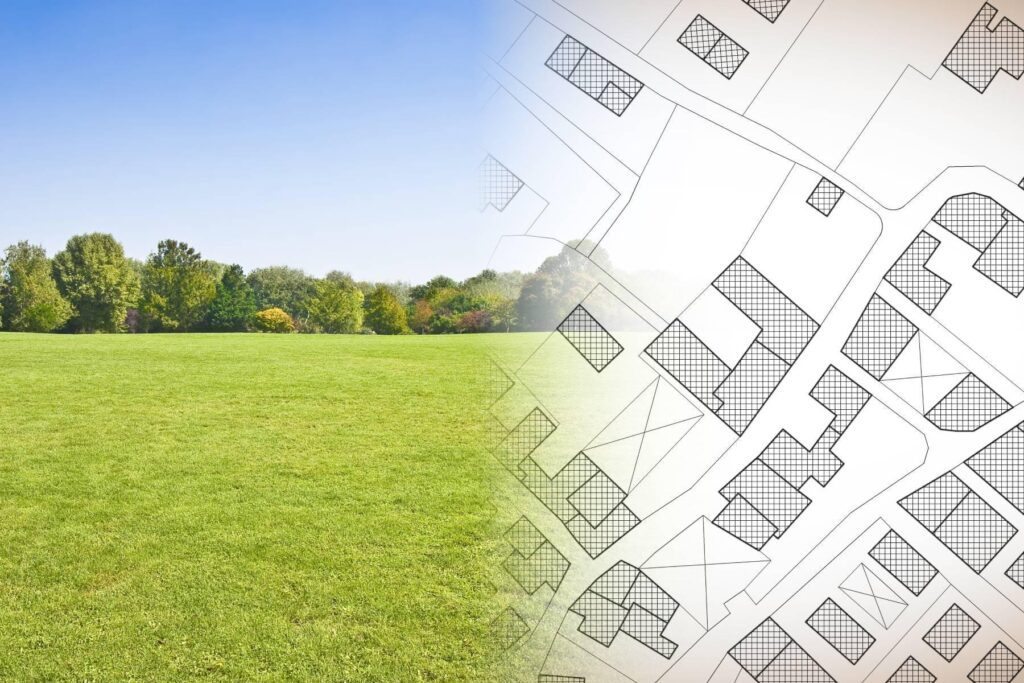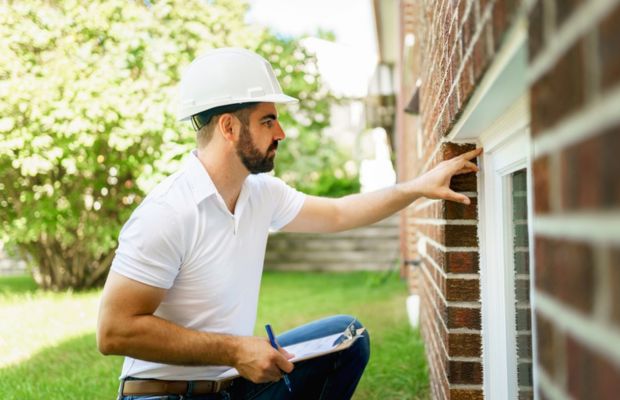If you own a plot of land, or your garden is large enough to accommodate a property, you could consider developing the land you already own.
But to do so, you’ll need to know about planning permission and the kind of mortgage required to fund your development.
Our guide explains everything you need to know…
How do I start developing land?
Often, the most complex part of developing land is funding it and buying it.
So, if you already own a piece of land, it can be easier to get started.
However, you’ll still need to consider things like planning permission and funding for your development.
Is developing land profitable?
Developing land can profitable – as long as you stay on top of your costs and know your objectives before you start.
Land with planning permission is generally worth more than land without, so if you’re thinking of selling land you own, you could consider a planning application to boost its value.
And if you’re thinking of building on land you own, you’ll need to consider:
• Will you live in what you build or sell it?
• If you’re selling your development, what kind of property will work for buyers in the area?
• If you’re building on your garden plot, how will what you build affect your current property’s value?
Common questions on self-build mortgages when developing land
In order to develop land you already own, you might require funding for the build.
A self-build mortgage is essentially development funding for the construction of a new property.
As you already own the land, you’ll only require funds for the build – but you’ll still need to be on top of your budget and complete your self-build within an allocated time agreed with your lender.
Here are some common questions around self-build mortgages…
1. How do I get a self-build mortgage when I already own land?
If you’re looking to develop land you already own, a self-build mortgage can provide you with the funds you need to complete work on a new property. Often, because you’re only funding the build and don’t need to borrow cash to buy land as well, there are more options available on self-build mortgages.
But it’s always best to speak to a mortgage broker in the first instance, who should be able to advise on lenders to approach.
2. How much can I borrow through a self-build mortgage?
The amount of money you can borrow through a self-build mortgage will depend on:
• Your personal circumstances and financial situation
• The amount of money you’re putting into the project yourself
• The value of the land you’re building on
• The total projected build cost
Some lenders will loan up against the value of your land, while others will lend based on the build cost itself.
Your lender will carry out an affordability assessment to consider your borrowing limits, so always seek independent financial advice before applying for a self-build mortgage.
3. How big a deposit do I need for a self-build mortgage?
Lenders will either lend against a valuation of the land you own or on your build costs.
While the criteria for each lender will vary depending on the specifics of your project, generally you can expect to get 75% to 80% of your land’s valuation figure as a self-build mortgage.
And if your lender is giving you a mortgage based on your build costs, you could also expect to receive up to 80%.
That means you’ll need to fund 20% to 30% of the project yourself, while it’s also good practice to build in a 10% to 20% contingency budget for unforeseen circumstances.
4. What type of self-build mortgage is best?
There are two main types of self-build mortgage:
• An arrears mortgage
• An advance mortgage
An arrears mortgage means you’ll receive payments as each stage of your self-build is completed.
An advance mortgage, meanwhile, means you’ll receive payments at the start of each stage of the build.
Arrears mortgages will be more suited to you if you have a larger amount of cash to fund your build, as you’ll be able to pay for any materials or labour up front.
However, if you’re taking on your self-build with less of your own money, an advance mortgage can work best as the lender will supply funding ahead of each build stage.
Arrears mortgages are more common and more widely available than advance mortgages but speak to a mortgage broker for advice and insight on your options.
5. Do I need planning permission to get a self-build mortgage?
Most self-build mortgage lenders will insist that you have full, detailed planning permission for your project before they lend to you.
While it’s possible to sometimes get a mortgage advance with only outline planning permission, if you fail to get detailed permission later, you will have to pay back your advance and factor in any associated costs.
Other options for self-build finance
Self-build mortgages can be a great way to fund the development of land you already own, but there are other options, including:
• Bridging finance
• Construction mortgages
• Personal loans
• Remortgaging an existing property
• Equity release
• Other business loans
Always speak to an independent financial advisor to discuss your options for taking on any finance for your self-build.
How to get planning permission on land
If you’re looking to develop land you already own, there’s a strong chance you’ll need to obtain planning permission for your build.
Planning can be complicated, so it’s useful to speak with an experienced planning consultant before making an application.
Here are some common questions around planning permission for developing land you own…
1. What can you build on land without planning permission?
Planning permission will almost certainly be required if you want to build a new dwelling on the land you own.
Large extensions or outbuildings also usually require planning permission.
Smaller additions to an existing property can usually be made under Permitted Development, but you should always check what’s permitted and what isn’t by speaking to your local planning department.
2. What can I build on agricultural land without planning permission?
If you own a piece of agricultural land and you’re looking to develop it, you’ll need to consider whether what you build requires planning permission.
Development that may not require planning permission includes:
• Construction of a building that is for the purposes of agriculture
• Buildings that are not dwellings or attached to dwellings
There are also rules around size and distance from other buildings, but the most important thing to know is if you’re looking to build a property on agricultural land, you’ll almost certainly need planning permission to do so.
3. What will planners look at when considering my application?
Whether you’re looking to build a property on your garden plot, or on another piece of land you own, the local authority planning department will consider:
• The impact of overlooking or loss of privacy for neighbouring properties
• Loss of light caused by new development
• Parking allocation and issues
• Road safety
• Increase in traffic and noise
• Impact on any listed buildings and conservation areas
• The layout and density of the proposed building
• The design and building methods / materials being used
• Any previous planning applications on the site
• Nature conservation impact
If there are objections from neighbours, your application will be called before the local planning committee for consideration and a decision will be made by a vote. If your application sparks no objections, it can be approved faster through what are known as designated powers.
4. What can I do if my planning application is refused?
If your planning application is rejected, you have the right to appeal.
Alternatively, you can make amendments to your application, dealing with the reasons for refusal, and re-submit.
5. How long does it take to get planning permission?
If you’re developing land you own, for instance your garden plot, and applying for permission for a single dwelling, you should find out if your planning application has been approved within eight weeks.
However, larger developments of multiple properties on bigger pieces of land can take longer.
And if your application is rejected and you need to make changes before re-submitting, the whole process could take around 18 months to two years.
Self-build mortgages and planning permission in Scotland
Planning permission in Scotland is much like the system in England and, if you’re looking to build a new home on a piece of land you own, you’ll almost certainly need planning consent.
As in England, smaller development work, such as extensions to existing properties, sometimes fall under Permitted Development – but you should always check with your local planning department if this is the case.
Self-build mortgages in Scotland, meanwhile, work in exactly the same way as they do in England – although Scottish self-build funding like this is not as widely available.
The Scotland Self-Build Loan Fund
The Scotland Self-Build Loan Fund was created by the Scottish government to help boost the construction of new homes.
Originally due to end in September 2021, the scheme has been extended for a further year due to the impact of Covid-19 – meaning loans of up to £175,000 are available until August 2022.
To be eligible for the self-build loan fund, you must:
• Be unable to access standard lending for your self-build
• Own the land you wish to build on, or have a contract to buy it
• Have detailed planning permission in place
Developing land and self-build funding in Wales
The planning process in Wales works in the same way as England.
So, if you’re aiming to build a new property on a piece of land you own, you’ll probably need to obtain planning permission.
Self-build mortgages are also available in Wales for those developing land they own.
Self Build Wales
If you’re keen to take on a self-build project but don’t have a piece of land to build on, you could consider the Self Build Wales scheme.
Through the scheme, you can apply to build on a plot of available land and, if successful, the pot will be awarded to you.
Self Build Wales will then help you find a builder and arrange funding through a self-build mortgage.
Further reading
Need inspiration for a home renovation project? Take a look at these great renovations from Instagram.
The property market, meanwhile, has remained buoyant early in 2021 – here’s everything you can expect from the market this year.
Finally, Japanese Knotweed can cause huge damage to property if left untreated – our guide on this invasive plant tells you how to spot it and how to deal with it.




